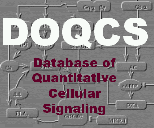
|
Enter a Search String | | Special character and space not allowed in the query term.
Search string should be at least 2 characters long. |
Molecule Parameter List for CaMKII | The statistics table lists the distribution of a molecule acting either as a substrate, product, enzyme or as a molecule within the network.
The text color of a molecule is highlighted by  color. color. | | Statistics |
Accession and Pathway Details | |
| Accession Name | Accession No. | Accession Type | Pathway Link | AMPAR_CaMKII_
weak_coupling | 65 | Network |
Shared_Object_AMPAR_CaMKII_weak_coupling, CaMKII, CaM,
PP1, PP2B, PP1_PSD,
AMPAR, PKA, AC,
AMPAR_memb, PP1_CaMKII_PSD, CaMKII_PSD | | This is a model of weak coupling between the AMPAR traffikcing bistability, and the CaMKII autophosphorylation bistability. In this model, there are three stable states: Both off, AMPAR on, or both on. The fourth possible state: CaMKII on but AMPAR off, is not truly stable, since over the course of hours the AMPAR also turns on. |
CaMKII acting as a Molecule in AMPAR_CaMKII_weak_coupling Network
| Name | Accession Name | Pathway Name | Initial Conc.
(uM) | Volume
(fL) | Buffered | | CaMKII | AMPAR_CaMKII_
weak_coupling
Accession No. : 65 | CaMKII
Pathway No. : 282 | 20 | 0.09 | No | | Huge conc of CaMKII. In PSD it is 20-40% of protein, so we assume it is around 2.5% of protein in spine as a whole. This level is so high it is unlikely to matter much if we are off a bit. This comes to about 70 uM. |
CaMKII acting as a Summed Molecule in AMPAR_CaMKII_weak_coupling Network
CaMKII acting as an Enzyme in AMPAR_CaMKII_weak_coupling Network
CaMKII acting as a Product of an Enzyme in AMPAR_CaMKII_weak_coupling Network
CaMKII acting as a Substrate in a reaction in AMPAR_CaMKII_weak_coupling Network
| Kd is calculated only for second order reactions, like nA+nB <->nC or nA<->nC+nD, where n is number and A,B,C,D are molecules, where as for first order reactions Keq is calculated.
Kd for higher order reaction are not consider. |
| Name | Accession Name | Pathway Name | Kf | Kb | Kd | tau | Reagents | | CaMKII-bind-CaM | AMPAR_CaMKII_
weak_coupling
Accession No. : 65 | CaMKII
Pathway No. : 282 | 49.9997
(uM^-1 s^-1) | 5
(s^-1) | Kd(bf) = 0.1(uM) | - | Substrate
CaM-Ca4
CaMKII
Product
CaMKII-CaM
| | This is tricky. There is some cooperativity here arising from interactions between the subunits of the CAMKII holoenzyme. However, the stoichiometry is 1. Kb/Kf = 6e4 #/cell. Rate is fast (see Hanson et al Neuron 12 943-956 1994) so lets say kb = 10. This gives kf = 1.6667e-4 H&S AnnRev Biochem 92 give tau for dissoc as 0.2 sec at low Ca, 0.4 at high. Low Ca = 100 nM = physiol. |
CaMKII acting as a Product in a reaction in AMPAR_CaMKII_weak_coupling Network
| Kd is calculated only for second order reactions, like nA+nB <->nC or nA<->nC+nD, where n is number and A,B,C,D are molecules, where as for first order reactions Keq is calculated.
Kd for higher order reaction are not consider. |
| Name | Accession Name | Pathway Name | Kf | Kb | Kd | tau | Reagents | | back_1 | AMPAR_CaMKII_
weak_coupling
Accession No. : 65 | CaMKII_PSD
Pathway No. : 292 | 0.3
(s^-1) | 0
(#^-1 s^-1) | Not applicable** | - | Substrate
CaMKII-PSD
Product
CaMKII
NMDAR
| | Rates set by the translocation experiments of Shen and Meyer, Science 1999. Note that this reaction also incorporates a translocation between compartments of different volumes. |
** This is a trasport reation between compartments of different volumes. Therefore Kd is not applicable. Please Note Kf, Kb units are in number of molecules instead of concentration
| Database compilation and code copyright (C) 2022, Upinder S. Bhalla and NCBS/TIFR
This Copyright is applied to ensure that the contents of this database remain freely available. Please see FAQ for details. |
|
